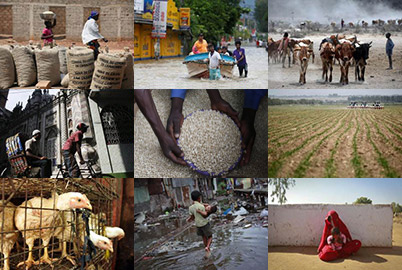* Any views expressed in this opinion piece are those of the author and not of Thomson Reuters Foundation.
I woke to a strong tremor on 25 April 2015.
My father was staying with me in Delhi. He was speaking to my mother on the telephone, who was in another corner of India. She said she’d felt the tremors too.
I soon learnt that the tremors were caused by one of the biggest earthquakes of the last four decades. It measured 7.8 on the Richter scale and destroyed Gorkha, Nepal, killing more than 8,800 people and injuring 23,000.
As part of child rights organisation Plan International’s response team, the countdown for my emergency deployment had started and I was on the plane to Kathmandu the next day.
We were flying with the media. It was a long, memorable journey that took almost 12 hours – it normally takes two to fly from Delhi to Kathmandu. Media interviews were taking place all around me and anxiety levels were high – we just didn’t know what to expect.
We failed to land the first time, as another major aftershock hit Kathmandu. Hats-off to Captain Khan of Indigo Airlines, though, whose determination helped us arrive safely.
A chilling sight
We landed in the evening. It was pouring with rain. Hundreds of people were waiting to be evacuated.
The sight of Kathmandu was spine-chilling. It resembled a dark bombed city, an eerie of silence hanging in the air. Cars were parked everywhere, but not a single person was in sight. The open spaces and parks were flooded with make-shift tents, while the sound of crying children could be heard in the dark night.
Each night in Kathmandu was filled with uncertainty. My colleagues and I slept with a grab bag next to our beds. Every time an aftershock rocked the room, we had to evacuate within seconds.
In between the continuous aftershocks, I could see Dr Unni Krishnan, Plan International’s Head of Disaster Response and Preparedness, being interviewed by major international media houses – often during the middle of night, amidst the aftershocks.
Devastated villages
The shaking continued. Then, from 10-11 June, a series of eight strong tremors hit Dolakha and Sinduplachowk, during a 36-hour period.
I was with a colleague from DG ECHO (the European Commission's Humanitarian Aid and Civil Protection Department), and she confessed: “I would prefer to stay in the tent than sleeping inside the hotel room in Dolakha.” We all felt the same, although I can only imagine how the villagers felt. The devastation was huge. More than 95% of houses collapsed, while families living in the makeshift tents had a big question mark of “uncertainty” hanging over their lives.
Padma, 65, lost everything to earthquake.
“As I was cutting green fodder for my cattle, the thunderous sound of the earthquake appeared suddenly, like a helicopter crash,” she told me. “My house collapsed. My children thought I had died inside and were searching for me everywhere.”
Padma now lives in a makeshift tent. Tears flow freely down her cheeks as she tells her story. Padma was able to survive on food supplied by Plan International and was given a tarpaulin and hygiene kit. She was also due to receive 20 kilograms of rice, but it was taken by someone, pretending to be her relative.
Her luck finally changed when she received two bundles of corrugated iron sheets and a toolkit from Plan International, funded by DG ECHO.
“I will now have a roof over my head and my children will help me make a transitional shelter,” she told me, happily.
Padma also received an unconditional cash transfer (UCT) of NPR 10,000 (USD ${esc.dollar}{esc.dollar}{esc.dollar}96) funded by the Disasters Emergency Committee (DEC), and plans to use it to repay the money she borrowed for food and construct a makeshift shelter.
“I am so happy with what I have received,” says Padma. “It has given me the flexibility to cover my basic needs.”
Community spirit
While in the field, I also met Maya, an 85 year old widow, still traumatised by the earthquake. “I was in my house when the earthquake struck. I am alive because my neighbour rescued me from the damaged house. Otherwise, who knows what might have happened. I live alone.”
Maya has since received corrugated iron sheets and an unconditional cash transfer. Villagers carried her sheeting, as part of their cash for work activities funded by DEC, and she’s confident they will help her rebuild her house. She plans to use money to re-build her house (with support from the community), and to buy food, shelter equipment and medicine. The aid distributed has given both Padma and Maya hope for the future.
For me, I still get goosebumps whenever I experience any loud noises or sudden vibrations. Yet, I am happy to see children slowly starting to smile again and to see life continuing amidst the uncertainty almost three months on.
Emergency shelter and non food item activities are funded by DGECHO from April to August 2015, led by Plan International, together with partners Save the Children and World Vision, in the Gorkha and Dolakha districts of Nepal. Plan International is distributing food, emergency shelter (tarpaulin and corrugated iron sheets) and non-food items, as well as multi-purpose cash transfers covering the basic needs of the affected population. Health, child protection and education in emergencies activities are also being implemented.
To find out more about Plan International's earthquake appeal, please click here.

